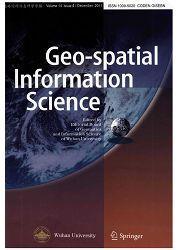Perspectives on the nature of geospatial information
IF 5.5
1区 地球科学
Q1 REMOTE SENSING
引用次数: 4
Abstract
In the first issue of this year, our editor-in-chief wrote an inspiring Editorial about the 20 years’ history of this journal. That forms a nice background to this Special Issue, in that he gave a very good overview of the journal’s aims and scope, and an interesting summary of geospatial information science, as well as some challenges for the future. During this 20th anniversary year, we will be producing two Special Issues to mark this auspicious occasion. It is a great pleasure that I am writing this guest editorial for the first of these two Special 20th Anniversary Issues for our journal on the subject of “Perspectives on the nature of geospatial information”. Since the introduction of remote sensing in the 1960s, of GIS in the 1970s, followed by GPS, and geospatial information technology, such technologies now permeate in all aspects of people’s daily lives. The advent of smartphones, social media, the cloud computing, big data, the Internet of Things, artificial intelligence (AI), robotics and automation, virtual reality, and several others have enabled many location-based services and other geospatial services to be used in construction, industry, commerce, agriculture, defense and security, disaster management, agriculture as well as many other application areas. The theme of this Special Issue, “Perspectives on the nature of geospatial information” was especially selected to show the wide range of different perspectives, approaches to, and applications of geospatial information. In this issue, we have included major contributions of the leading geospatial information science practitioners and organizations that have shaped this dynamic field. There are 13 papers in it, with authors coming from 13 countries, showing the truly international nature of this journal. We have some excellent review papers on policy, at the global and national levels, as well as overview/status papers with various perspectives on the nature of geospatial information. These include technical, educational, commercial, industrial, security, scientific perspectives on the nature of geospatial information, as well as on geospatial standards issues, in addition to some application examples. The papers also cover many different parts of the world.关于地理空间信息本质的观点
在今年的第一期,我们的主编写了一篇关于本刊20年历史的鼓舞人心的社论。这为本期特刊提供了一个很好的背景,因为他很好地概述了该杂志的目标和范围,并对地理空间信息科学进行了有趣的总结,以及未来的一些挑战。在20周年纪念之际,我们将出版两期特刊,以纪念这一吉祥的时刻。我很高兴为《地理空间信息》杂志20周年特刊的第一期撰写客座社论,主题是“地理空间信息的本质透视”。自20世纪60年代的遥感、70年代的地理信息系统、随后的GPS和地理空间信息技术问世以来,这些技术已经渗透到人们日常生活的方方面面。智能手机、社交媒体、云计算、大数据、物联网、人工智能、机器人和自动化、虚拟现实等技术的出现,使许多基于位置的服务和其他地理空间服务被用于建筑、工业、商业、农业、国防和安全、灾害管理、农业以及许多其他应用领域。本期特刊的主题是“地理空间信息的本质”,以展示地理空间信息的各种不同观点、方法和应用。在这期杂志中,我们收录了地理空间信息科学的主要实践者和组织的主要贡献,他们塑造了这个充满活力的领域。收录了13篇论文,作者来自13个国家,真正体现了本刊的国际性。我们有一些关于全球和国家层面政策的优秀综述论文,以及从不同角度阐述地理空间信息本质的综述/现状论文。这些包括技术、教育、商业、工业、安全、关于地理空间信息性质的科学观点,以及地理空间标准问题,此外还有一些应用实例。这些报纸还覆盖了世界上许多不同的地区。
本文章由计算机程序翻译,如有差异,请以英文原文为准。
求助全文
约1分钟内获得全文
求助全文
来源期刊

Geo-spatial Information Science
REMOTE SENSING-
CiteScore
10.10
自引率
28.30%
发文量
710
审稿时长
31 weeks
期刊介绍:
Geo-spatial Information Science was founded in 1998 by Wuhan University, and is now published in partnership with Taylor & Francis. The journal publishes high quality research on the application and development of surveying and mapping technology, including photogrammetry, remote sensing, geographical information systems, cartography, engineering surveying, GPS, geodesy, geomatics, geophysics, and other related fields. The journal particularly encourages papers on innovative applications and theories in the fields above, or of an interdisciplinary nature. In addition to serving as a source reference and archive of advancements in these disciplines, Geo-spatial Information Science aims to provide a platform for communication between researchers and professionals concerned with the topics above. The editorial committee of the journal consists of 21 professors and research scientists from different regions and countries, such as America, Germany, Switzerland, Austria, Hong Kong and China.
 求助内容:
求助内容: 应助结果提醒方式:
应助结果提醒方式:


